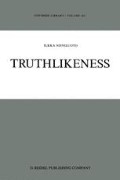Abstract
After the preparations in Chapters 1–4, we are now ready to attack the main problem of this book, viz. the concept of truthlikeness. This chapter discusses the historical background and the intuitive motivation underlying this concept. Some of the frequent confusions associated with this explicandum are explained by distinguishing it from a number of related concepts, such as probability, partial truth, degree of truth, and approximate truth. An exposition and criticism of Karl Popper’s qualitative and quantitative notions of verisimilitude is also given. The programme for explicating truthlikeness that I myself advocate is then formulated in general terms in the next two chapters.
Access this chapter
Tax calculation will be finalised at checkout
Purchases are for personal use only
Preview
Unable to display preview. Download preview PDF.
Notes
For this distinction, see Niiniluoto (1984b), Ch. 3.
See Chapter 12.
See Laudan (1981), Ch. 14.
Such sentences have been called ‘partially true’ (pacceka sacca) in the Buddhist tradition. To mistake a part for a whole is an example where a statement corresponds only “to some extent with facts”: a blind man reports that the whole elephant is like the part (ears, forehead, etc.) that he touches (see Jayatilleke, 1971, p. 57).
Peirce’s theory of induction has been interpreted in both ways: successive inductions give a sequence of false point estimates which converge towards the truth (cf. Niiniluoto, 1984b, Ch. 3), or a sequence of more and more narrow interval estimates (see Levi, 1980b).
For a logician, it is tempting to try to give a recursive definition of the concept Ω ⊢ r h (h is true to the degree r in structure Ω) by imitating and modifying the clauses of Tarski’s definition (2.1). For attempts toward this direction, see Weston (1977, 1981), Chuaqui and Bertossi (1985). However, as we shall see also in Chapter 6, this strategy fails, since degrees of truth (approximate truth, truthlikeness) are truth-functional only in a very limited sense. For example, it may happen that both h 1 and h 2 are approximately true in Ω, but still h 1 & h 2 is a logical contradiction.
The definition of the classes T and F have to be relativized to a language L: the class of all truths in all possible languages hardly makes sense. Popper is not worried about this relativity, as we can judge from his comments on the “myth of the framework” (Popper, 1970, p. 56). Problems of linguistic relativity and conceptual incommensurability are discussed below in Chapter 13.2.
Hattiangadi (1975) informs that C. G. Hempel had proved essentially the same negative result already in 1970; the given proof is valid for finitely axiomatizable theories.
For a comment on Agassi’s (1981) attempt to save Popper’s definition, see Notes 3 to Chapter 8. Cf. also Perry (1982). Newton-Smith’s (1981) definition of verisimilitude is convincingly criticized by Oddie (1986).
Note that Vs(h) cannot be defined in terms of the cardinalities of the truth content and the falsity content of h (cf. Robinson, 1971), since each sentence h in a first-order language L has an infinite number of true and false consequences in L (see Miller, 1972). For comments on Popper’s measure Vs, see also Keuth (1976) and Grünbaum (1976a, b).
Author information
Authors and Affiliations
Rights and permissions
Copyright information
© 1987 D. Reidel Publishing Company, Dordrecht, Holland
About this chapter
Cite this chapter
Niiniluoto, I. (1987). The Concept of Truthlikeness. In: Truthlikeness. Synthese Library, vol 185. Springer, Dordrecht. https://doi.org/10.1007/978-94-009-3739-0_5
Download citation
DOI: https://doi.org/10.1007/978-94-009-3739-0_5
Publisher Name: Springer, Dordrecht
Print ISBN: 978-94-010-8170-2
Online ISBN: 978-94-009-3739-0
eBook Packages: Springer Book Archive

